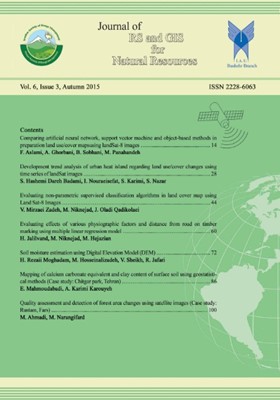Comparing artificial neural network, support vector machine and object-based methods in preparation land use/cover mapsusing landSat-8 images
Subject Areas : Geospatial systems development
Farnoush Aslami
1
,
Ardavan Ghorbani
2
![]() ,
Behrouz Sobhani
3
,
Mohsen Panahandeh
4
,
Behrouz Sobhani
3
,
Mohsen Panahandeh
4
1 - MSc. Graduated of Remote Sensing and GIS, University of Mohaghegh Ardabili
2 - Assoc. Prof. College of Agricultural Technology and Natural Resources , University of Mohaghegh Ardabili
3 - Assoc. Prof. College of Humanities, University of Mohaghegh Ardabili
4 - MSc. of Geography, Space Organization of Iran
Keywords:
Abstract :
Preparing the maps of land use/cover for spatial planning and management is essential. Nowadays, satellite images and remote sensing techniques have widespread applications according to their capabilities to produce the updated data and analyze the images in all disciplines such as agriculture and natural resources. In the present study, Artificial Neural Network, Support Vector Machines and Object-Based techniques wereutilized for drawing the land use and vegetation maps in Ardabil, Namin, and Nir counties. The images of LandSat-8 Operational Land Imager (OLI) (2013) were usedafter geometric correction and topographic normalization and classified into 9 land use/cover classes including water bodies, irrigated farming, rainfed farming, meadows, outcrops, forests, rangelands, residential and airport areas. After the accuracy assessment, overall accuracy for the produced maps of ANN, Support Vector Machine (SVM) and Object-based (OB) techniques was estimated as 89.91, 85.68 and 94.37%, respectively and Kappa's coefficients were 0.88, 0.82 and 0.93, respectivelyindicating that the object-based method in comparison with two other methods has more advantages;on the other hand, all three methods could provide the desirable accuracy for the land use/covermaps. Overally, three advanced classification methods were examined in the heterogeneous area with elevation changes up to 3600m using the images of new lunched Landsat 8 and the most appropriate land use/cover mapping method was introduced.


